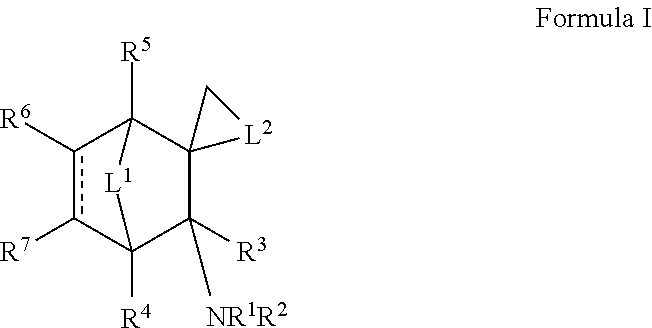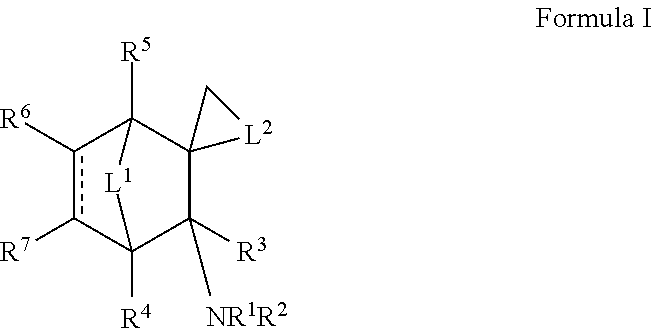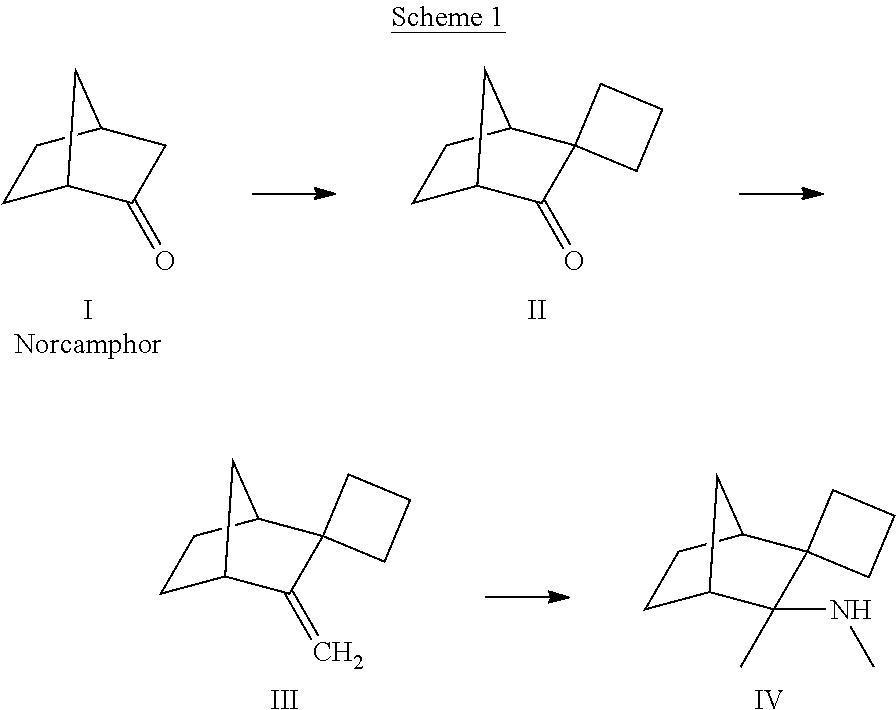Nicotinic receptor non-competitive antagonists
a technology of the nicotinic receptor and the antagonist, which is applied in the direction of biocide, cardiovascular disorder, drug composition, etc., can solve the problems of complex receptor modulation, and achieve the effect of reducing pain and hypertension
- Summary
- Abstract
- Description
- Claims
- Application Information
AI Technical Summary
Benefits of technology
Problems solved by technology
Method used
Image
Examples
example 1
Exo-N,3-dimethylspiro[bicyclo[2.2.1]heptane-2,1′-cyclobutan]-3-amine
[0104]To a solution of 2-norbornanone (norcamphor) (16.0 g, 145 mmol) and 1,3-dibromopropane (203 mmol, 20.7 mL; 41.1 g) in diethyl ether (450 mL) was added sodium amide (363 mmol, 14.8 g) and the mixture was stirred at reflux for 24 h. The mixture was poured into 200 mL of ice-water, and the organic layer was separated. The aqueous layer was extracted with 200 mL of ether. The combined ether extracts were concentrated, and the liquid residue was distilled at 60-100° C. at 10-20 Torr vacuum to obtain 14 g of impure product. This was dissolved in 150 mL of hexanes and stirred with a solution of potassium permanganate (12.0 g, 75.9 mind) in water (150 mL) for 5 h. The biphasic mixture was filtered through a bed of diatomaceous earth, which was then washed with hexanes (100 mL). The hexane layer was separated, and the aqueous layer was extracted with 600 mL of hexanes. The hexane layers were combined, concentrated, and...
example 2
Chiral Chromatographic Separation of exo-N,3-dimethylspiro[bicyclo[2.2.1]heptane-2,1′-cyclobutan]-3-amine
[0108]Exo-N,3-dimethylspiro[bicyclo[2.2.1]heptane-2,1′-cyclobutan]-3-amine (2.0 g) was dissolved in 20 mL of acetonitrile and was separated with 0.2 mL, injections on chiral column (Chiral Pak AD-H, 5 micron, 250×20 cm), using 0.2% diethylamine in acetonitrile / isopropanol (95:5), with a flow rate of 10 mL / min. Fractions containing peak 1 (early eluting) and peak 2 (late eluting) were separately concentrated. The two residues were individually dissolved in 10 mL of dichloromethane, treated with 2 mL of 6N aqueous hydrochloric acid, and concentrated to dryness. These hydrochloride salt products weighed 0.74 g (peak 1) and 0.48 g (peak 2), respectively.
example 3
N,3-dimethylspiro[bicyclo[2.2.1]heptane-2,1′-cyclopentan]-3-amine
[0109]To a solution of 2-norbornanone (25.0 g, 227 mmol) and 1,4-dibromobutane (68.0 g, 317 mmol) in diethyl ether (700 mL) was added sodium amide (23.1 g, 567 mmol). This mixture was heated at reflux for 24 h, cooled and poured into 200 mL of ice-water. The organic layer was collected, and the aqueous layer was extracted with 200 mL, of diethyl ether. The combined diethyl ether extracts were concentrated, and the residue was distilled at 65-80° C. at 7-15 Torr to obtain 19 g of impure product. This was dissolved in hexanes (500 mL) and stirred with aqueous potassium permanganate (30 g, 0.19 mol, in 500 mL) for 5 h. The mixture was filtered, and the hexane layer was collected. The aqueous layer was extracted with 600 mL of hexanes. The combined hexane layers were concentrated, and the residue purified on a silica gel column, eluting with 5-15% ethyl acetate in hexanes, to obtain spiro[bicyclo[2.2.1]heptane-2,1′-cyclope...
PUM
| Property | Measurement | Unit |
|---|---|---|
| temperature | aaaaa | aaaaa |
| temperature | aaaaa | aaaaa |
| pH | aaaaa | aaaaa |
Abstract
Description
Claims
Application Information
 Login to View More
Login to View More - R&D
- Intellectual Property
- Life Sciences
- Materials
- Tech Scout
- Unparalleled Data Quality
- Higher Quality Content
- 60% Fewer Hallucinations
Browse by: Latest US Patents, China's latest patents, Technical Efficacy Thesaurus, Application Domain, Technology Topic, Popular Technical Reports.
© 2025 PatSnap. All rights reserved.Legal|Privacy policy|Modern Slavery Act Transparency Statement|Sitemap|About US| Contact US: help@patsnap.com



